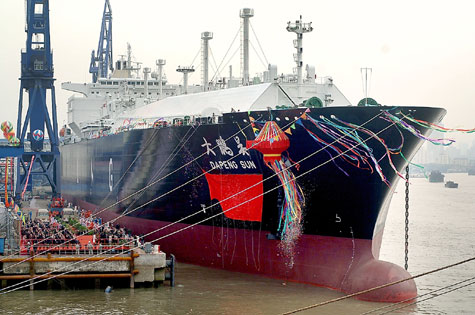China's first self-built liquefied natural gas carrier was delivered to its owner in Shanghai yesterday and will soon sail on the Australia-Guangdong route to load the clean fuel to China's south.
"It's a major milestone in China's shipbuilding industry. Now we are able to produce LNG tankers on a large scale," said Xiao Hongxing, chief engineer of Hudong-Zhonghua Shipbuilding (Group) Co, the LNG carrier's builder.

Dapeng Sun, China's first self-built liquefied natural gas carrier, is delivered to its owner in Shanghai yesterday. The vessel, which cost US$160 million to build, has a capacity of 147,000 cubic meters, or about 70,000 tons, of LNG. Built by Shanghai-based Hudong-Zhonghua Shipbuilding (Group) Co, the ship will sail on the Australia-Guangdong route to load the clean fuel to south China.
Building an LNG vessel requires the highest level of shipbuilding technology since the ships must be equipped with tanks that can withstand extremely low temperatures. Until now, only a few shipyards in Japan, the Republic of Korea and some European nations have been capable of building the special-purpose tankers.
The vessel, which cost US$160 million to build, has a capacity of 147,000 cubic meters, or about 70,000 tons, of LNG - equivalent to one-month use for Shanghai residents. Construction of the first LNG carrier started late in 2004.
Named Dapeng Sun, it will carry LNG from Australia to Guangdong Province's Dapeng, China's first LNG receiving terminal, partly replacing the service now offered by foreign-flagged vessels.
Xiao said there was some delay in delivery after builders found problems in pipe parts supplied by one domestic company. He also said construction costs had risen a lot over the past few years.
The Shanghai-based Hudong-Zhonghua is building another four LNG vessels with the same capacity. Two will be delivered for the Dapeng project this year and next year. The other two are being made for the LNG terminal in Fujian Province.
For sea transportation, natural gas is super-chilled to a liquid state at minus 163 degrees Celsius, giving it only one-six-hundredth of its original volume.
The Dapeng Sun can complete a return trip between Australia and Guangdong twice a month and will carry more than 1.4 million tons of LNG annually, according to its owners - a consortium of investors including China Ocean Shipping (Group) Co and BHP Billiton Petroleum (North West Shelf) Pty Ltd.
The Dapeng terminal, which started to receive LNG from Australia in June 2006 under a long-term contract, had imported four million tons by the end of 2007. It imported three million tons in 2007, equivalent to a third of the nationwide natural gas consumption.
China's LNG imports are expected to reach 19 million tons in 2010. The government has approved several LNG terminals in Guangdong, Fujian, Shanghai and Zhejiang and is planning others. Upon arrival, the LNG is converted back to gas to supply households, power stations and factories.
(Shanghai Daily April 4, 2008)